The Last Campfire offers a unique blend of puzzle design and emotional storytelling that enhances player engagement. This article explores the core elements of puzzle design, the immersive narrative experience, and the emotional resonance that makes the game memorable. It highlights the integration of puzzles with the story, the relatable themes of loss and hope, and the challenges players face in navigating the beautifully crafted environments. By focusing on exploration and reflection, players can deepen their connection to the protagonist’s journey.
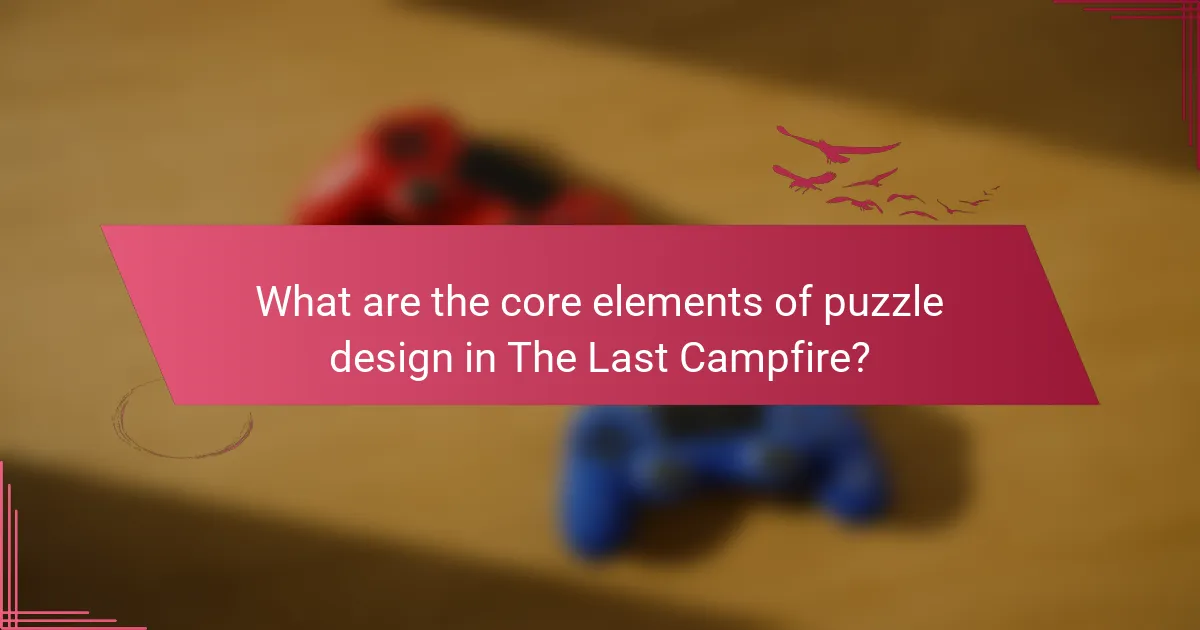
What are the core elements of puzzle design in The Last Campfire?
The core elements of puzzle design in The Last Campfire include environmental interaction, narrative integration, and emotional engagement. Each puzzle is crafted to enhance the player’s journey, blending seamlessly with the story and evoking feelings of curiosity and reflection. The puzzles often require players to manipulate objects within the environment, emphasizing exploration and discovery. Additionally, the design prioritizes simplicity, allowing players to focus on the emotional resonance of their choices rather than complex mechanics. Each element contributes to a cohesive experience that aligns with the game’s thematic depth.
How does puzzle complexity impact player engagement?
Puzzle complexity significantly enhances player engagement in “The Last Campfire.” Higher complexity levels challenge players, fostering deeper investment in problem-solving. This engagement leads to a stronger emotional connection to the narrative. Players experience satisfaction from overcoming intricate puzzles, which amplifies their overall enjoyment. Balancing complexity ensures players remain motivated without feeling frustrated, maintaining a positive experience throughout the game.
Which design principles enhance the narrative experience?
Effective design principles that enhance the narrative experience in “The Last Campfire” include emotional engagement, environmental storytelling, and player agency. These principles deepen the connection between players and the unfolding story.
Emotional engagement is achieved through relatable character arcs and immersive soundscapes. Environmental storytelling uses visual cues and interactive elements to convey backstory without explicit exposition. Player agency allows choices that influence the narrative, making experiences feel personal and impactful.
These attributes collectively foster an enriching narrative experience, resonating with players emotionally and intellectually.
What role does environmental storytelling play in puzzles?
Environmental storytelling enhances puzzles by immersing players in a narrative that deepens engagement. In “The Last Campfire,” this approach connects puzzle-solving to emotional experiences, creating a cohesive gameplay experience. Players uncover layers of story through environmental clues, which enrich the atmosphere and foster a sense of discovery. This design choice promotes emotional resonance, making each puzzle feel integral to the overarching narrative. The unique attribute of this game lies in its ability to intertwine narrative and gameplay seamlessly, elevating player investment in the story.
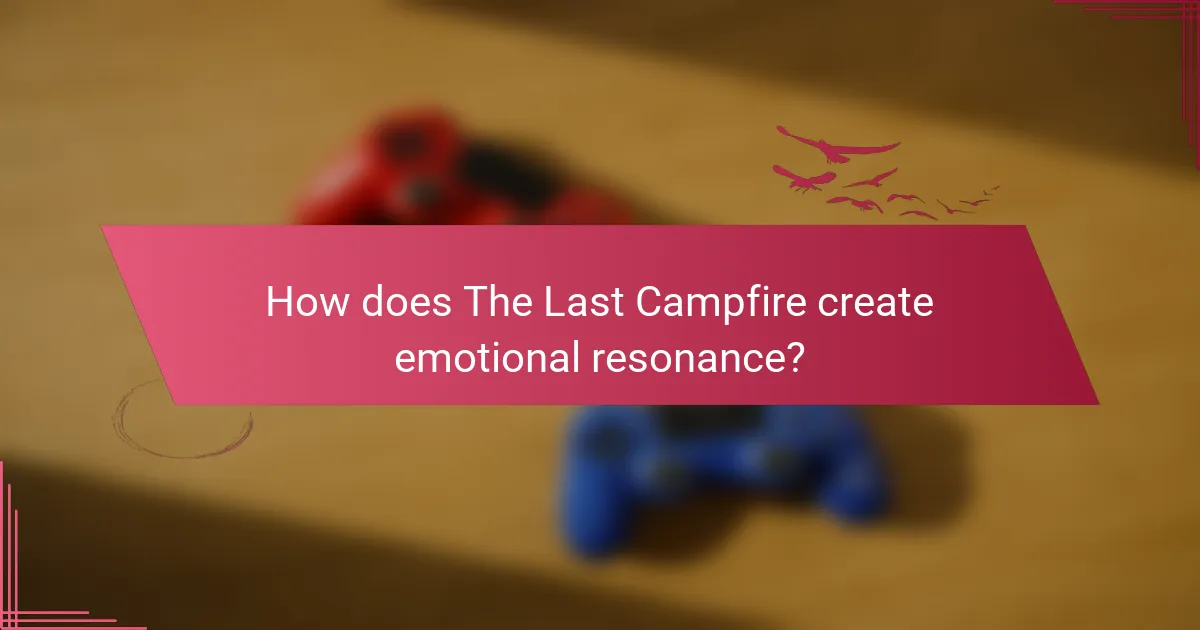
How does The Last Campfire create emotional resonance?
The Last Campfire creates emotional resonance through its immersive narrative and relatable themes. The game’s story explores loss, hope, and the journey to find purpose, making players connect deeply with the protagonist’s struggles. Puzzle design enhances this experience, encouraging reflection and engagement with the emotional landscape. Unique visual aesthetics and soundscapes further amplify feelings, creating a memorable atmosphere that resonates with players long after gameplay.
What techniques are used to evoke empathy in players?
The Last Campfire evokes empathy in players through immersive storytelling, emotional character development, and relatable themes. The narrative invites players to connect with characters facing loss and hope, fostering emotional investment. Puzzle design enhances this connection by integrating challenges that reflect the characters’ emotional journeys, encouraging players to empathize with their struggles. Additionally, the game’s art style and sound design create an atmosphere that deepens emotional resonance, making the experience more impactful.
How do character arcs contribute to emotional depth?
Character arcs significantly enhance emotional depth by allowing players to connect with characters’ growth and struggles. In “The Last Campfire,” these arcs drive the narrative, making emotional moments resonate deeply. Players experience transformation through challenges, fostering empathy and investment in the story. The unique attribute of character development in this game creates a memorable emotional journey, reinforcing the narrative’s impact.
Which narrative choices amplify emotional impact?
Narrative choices that emphasize character development and emotional stakes amplify the emotional impact in “The Last Campfire.” Engaging storytelling techniques, such as using relatable backstories and meaningful interactions, create deeper connections with players. Unique attributes like environmental storytelling and visual symbolism enhance the emotional resonance of the narrative experience. As a result, players feel more invested in the journey and outcomes of the characters.
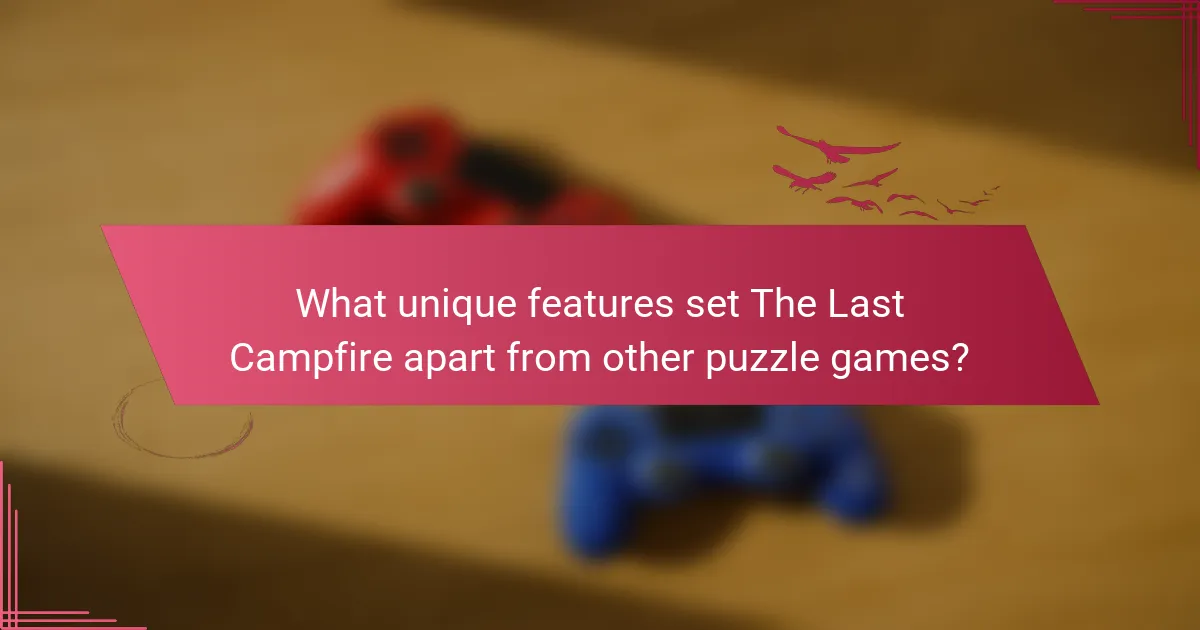
What unique features set The Last Campfire apart from other puzzle games?
The Last Campfire stands out due to its unique combination of immersive narrative, emotional depth, and innovative puzzle design. The game focuses on storytelling, allowing players to connect with the protagonist’s journey, enhancing emotional resonance. Its puzzles are thoughtfully integrated into the narrative, providing a seamless experience that encourages exploration and reflection. The art style and atmospheric sound design further enrich the overall experience, creating a distinctive ambiance that sets it apart from typical puzzle games.
How does art style influence player perception and mood?
Art style significantly shapes player perception and mood in “The Last Campfire.” The game’s visual aesthetics, characterized by a warm color palette and whimsical designs, evoke feelings of comfort and curiosity. This emotional resonance enhances the narrative experience, encouraging players to engage deeply with the story and puzzles. Unique attributes, such as the handcrafted art style, create a distinct atmosphere that differentiates it from other titles. As a result, players often report a sense of calm and reflection while navigating its challenges.
What innovative gameplay mechanics differentiate it from competitors?
The Last Campfire features innovative gameplay mechanics that enhance puzzle design and emotional engagement. Its unique attribute is the integration of environmental storytelling, which immerses players in a rich narrative experience. Additionally, the game employs a distinctive approach to puzzle-solving, encouraging exploration and experimentation. This contrasts with competitors by fostering emotional resonance through character-driven narratives and visually stunning environments. The combination of these elements creates a compelling gameplay experience that stands out in the indie game landscape.
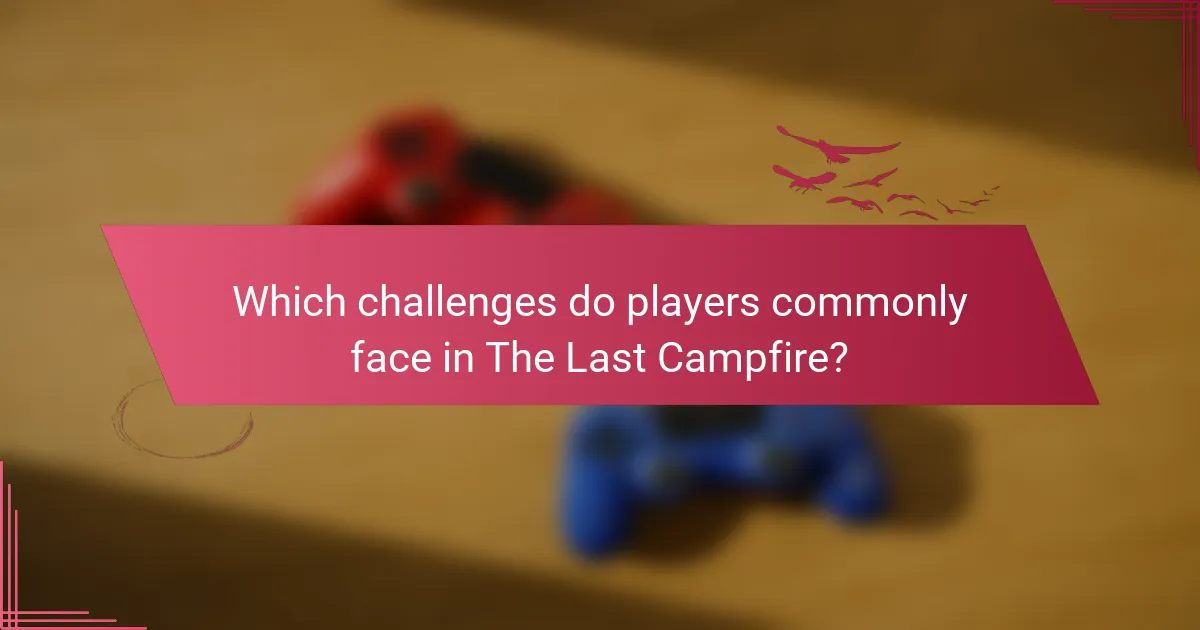
Which challenges do players commonly face in The Last Campfire?
Players commonly face challenges related to puzzle complexity, emotional storytelling, and environmental navigation in The Last Campfire. The intricate puzzles often require critical thinking and patience. The narrative experience can evoke strong emotions, which may lead to moments of frustration or reflection. Additionally, navigating the beautifully crafted environments can pose challenges in terms of exploration and understanding clues, impacting overall gameplay.
How do players overcome frustration with difficult puzzles?
Players overcome frustration with difficult puzzles in “The Last Campfire” by employing strategies that enhance their problem-solving skills. They often take breaks to clear their minds, allowing for fresh perspectives. Collaborating with others can provide new insights, as sharing ideas can spark creative solutions. Players also benefit from analyzing puzzle patterns, which helps them recognize recurring themes and mechanics. Utilizing in-game hints or guides can offer necessary assistance without detracting from the experience. Engaging with the narrative and emotional resonance of the game can motivate players to persist through challenges, reinforcing their connection to the story and characters.
What support systems are in place for players struggling with the narrative?
Support systems for players struggling with the narrative in “The Last Campfire” include in-game guidance, community forums, and developer resources. These systems help players navigate emotional challenges and enhance their experience.
In-game guidance offers hints and tips to assist players facing narrative obstacles. Community forums provide a platform for sharing experiences and strategies, fostering a supportive environment. Developer resources, such as FAQs and updates, address player concerns and improve understanding of the narrative’s depth.
These support mechanisms aim to enhance emotional resonance and ensure players remain engaged with the story.
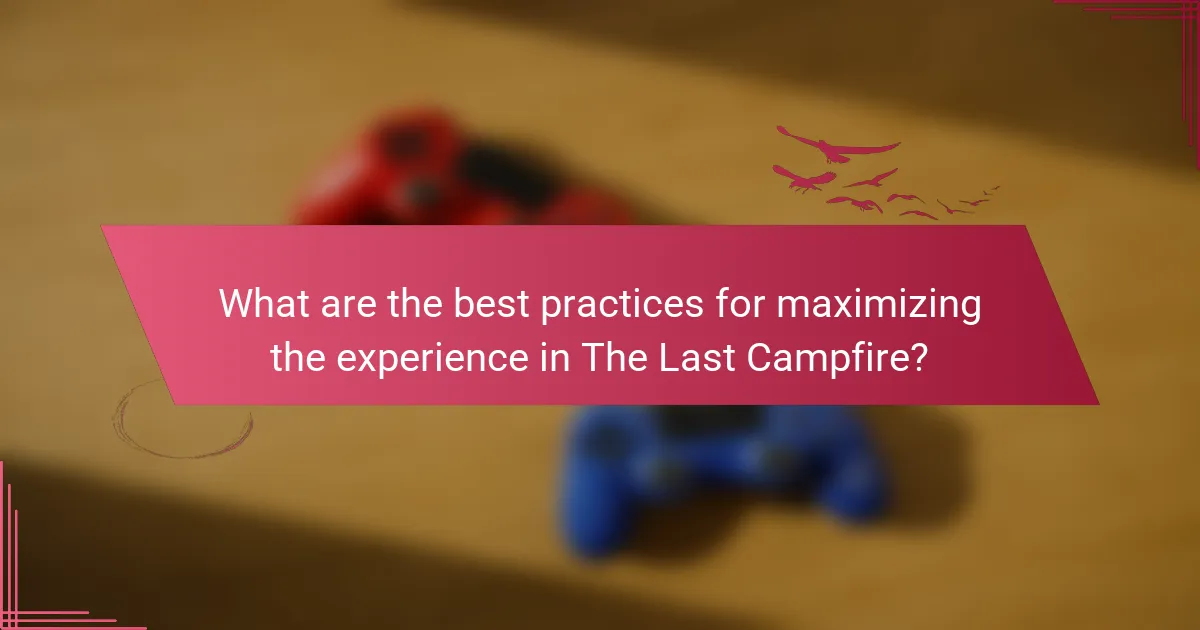
What are the best practices for maximizing the experience in The Last Campfire?
To maximize the experience in The Last Campfire, focus on exploration, puzzle-solving, and emotional engagement. Engage deeply with the narrative and environment to uncover hidden stories and meanings.
1. Explore thoroughly to find collectibles that enhance the story.
2. Take time to solve puzzles, as they are designed to evoke thought and reflection.
3. Pay attention to character interactions for emotional depth and resonance.
4. Embrace the atmosphere and art style, which contribute significantly to the overall experience.
How can players enhance their engagement with the narrative?
Players can enhance their engagement with the narrative by actively exploring the environment and interacting with characters. This approach deepens emotional resonance and understanding of the story. Immersive puzzle design encourages players to think critically, creating a sense of investment in the narrative. Additionally, reflecting on character motivations and choices can lead to a more profound connection with the storyline. Engaging with the game’s themes fosters a richer experience, making players feel integral to the unfolding narrative.
What strategies can improve puzzle-solving efficiency?
Engaging with the narrative and emotional elements of “The Last Campfire” enhances puzzle-solving efficiency. Players should focus on understanding character motivations, which can provide clues to solutions. Additionally, practicing patience and exploring every environment can reveal hidden interactions. Collaborating with others can also foster new perspectives on challenges, leading to quicker resolutions.
Which common mistakes should players avoid to fully appreciate the game?
Players should avoid common mistakes to fully appreciate “The Last Campfire.” One key error is rushing through puzzles without exploring the environment. Engaging with the narrative enhances emotional resonance. Another mistake is overlooking the significance of collectibles, which deepen the story. Failing to reflect on character interactions can diminish the overall experience. Lastly, not experimenting with different approaches to puzzles can limit creative problem-solving.


